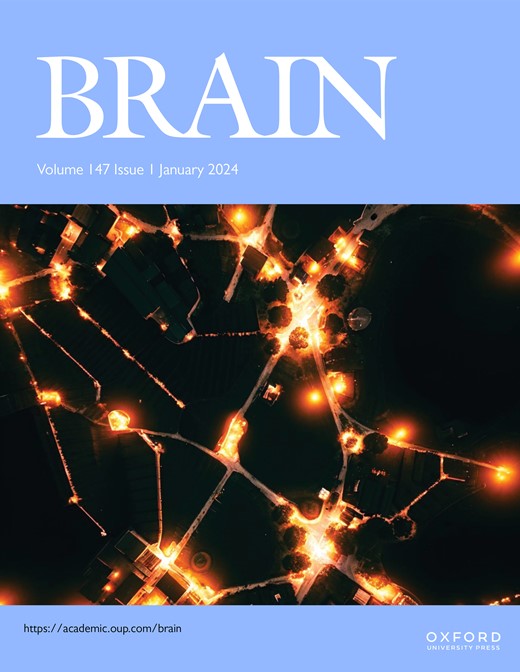Myelination potential and injury susceptibility of grey versus white matter human oligodendrocytes
IF 10.6
1区 医学
Q1 CLINICAL NEUROLOGY
引用次数: 0
Abstract
Increasing evidence indicates heterogeneity in functional and molecular properties of oligodendrocyte lineage cells both during development and under pathologic conditions. In multiple sclerosis, remyelination of grey matter lesions exceeds that in white matter. Here we used cells derived from grey matter versus white matter regions of surgically resected human brain tissue samples, to compare the capacities of human A2B5-positive progenitor cells and mature oligodendrocytes to ensheath synthetic nanofibers, and relate differences to the molecular profiles of these cells. For both cell types, the percentage of ensheathing cells was greater for grey matter versus white matter cells. For both grey matter and white matter samples, the percentage of cells ensheathing nanofibers was greater for A2B5-positive cells versus mature oligodendrocytes. Grey matter A2B5-positive cells were more susceptible than white matter A2B5-positive cells to injury induced by metabolic insults. Bulk RNA sequencing indicated that separation by cell type (A2B5-positive vs mature oligodendrocytes) is more significant than by region but segregation for each cell type by region is apparent. Molecular features of grey matter versus white matter derived A2B5-positive and mature oligodendrocytes were lower expression of mature oligodendrocyte genes and increased expression of early oligodendrocyte lineage genes. Genes and pathways with increased expression in grey matter derived cells with relevance for myelination included those related to responses to external environment, cell-cell communication, cell migration, and cell adhesion. Immune and cell death related genes were up-regulated in grey matter derived cells. We observed a significant number of up-regulated genes shared between the stress/injury and myelination processes, providing a basis for these features. In contrast to oligodendrocyte lineage cells, no functional or molecular heterogeneity was detected in microglia maintained in vitro, likely reflecting the plasticity of these cells ex vivo. The combined functional and molecular data indicate that grey matter human oligodendrocytes have increased intrinsic capacity to myelinate but also increased injury susceptibility, in part reflecting their being at a stage earlier in the oligodendrocyte lineage.人类灰质和白质少突胶质细胞的髓鞘化潜能和易受伤性
越来越多的证据表明,少突胶质细胞系细胞在发育过程中和病理条件下的功能和分子特性存在异质性。在多发性硬化症中,灰质病变部位的再髓鞘化超过了白质。在这里,我们利用从手术切除的人类脑组织样本的灰质区域和白质区域提取的细胞,比较了人类 A2B5 阳性祖细胞和成熟少突胶质细胞包裹合成纳米纤维的能力,并将差异与这些细胞的分子特征联系起来。对这两种细胞类型而言,灰质细胞与白质细胞的包被细胞比例更高。在灰质和白质样本中,A2B5 阳性细胞包被纳米纤维的细胞比例高于成熟少突胶质细胞。灰质 A2B5 阳性细胞比白质 A2B5 阳性细胞更容易受到代谢损伤的影响。大量 RNA 测序表明,按细胞类型(A2B5 阳性细胞与成熟少突胶质细胞)进行的分离比按区域进行的分离更为显著,但每种细胞类型按区域的分离也很明显。灰质与白质衍生的 A2B5 阳性和成熟少突胶质细胞的分子特征是成熟少突胶质细胞基因表达较低,而早期少突胶质细胞系基因表达较高。灰质衍生细胞中与髓鞘化相关的基因和通路表达增加,包括与对外部环境反应、细胞-细胞通讯、细胞迁移和细胞粘附相关的基因和通路。在灰质衍生细胞中,与免疫和细胞死亡相关的基因被上调。我们观察到大量上调基因在应激/损伤和髓鞘化过程中共享,为这些特征提供了依据。与少突胶质细胞系细胞相反,体外培养的小胶质细胞没有发现功能或分子异质性,这可能反映了这些细胞在体内外的可塑性。综合功能和分子数据表明,灰质人类少突胶质细胞具有更强的髓鞘化内在能力,但也具有更强的损伤易感性,这在一定程度上反映了它们处于少突胶质细胞系的早期阶段。
本文章由计算机程序翻译,如有差异,请以英文原文为准。
求助全文
约1分钟内获得全文
求助全文
来源期刊

Brain
医学-临床神经学
CiteScore
20.30
自引率
4.10%
发文量
458
审稿时长
3-6 weeks
期刊介绍:
Brain, a journal focused on clinical neurology and translational neuroscience, has been publishing landmark papers since 1878. The journal aims to expand its scope by including studies that shed light on disease mechanisms and conducting innovative clinical trials for brain disorders. With a wide range of topics covered, the Editorial Board represents the international readership and diverse coverage of the journal. Accepted articles are promptly posted online, typically within a few weeks of acceptance. As of 2022, Brain holds an impressive impact factor of 14.5, according to the Journal Citation Reports.
 求助内容:
求助内容: 应助结果提醒方式:
应助结果提醒方式:


